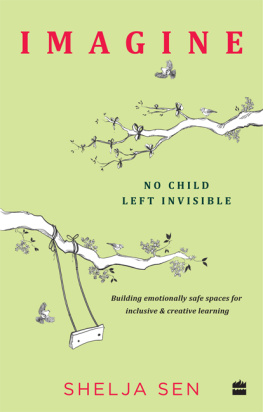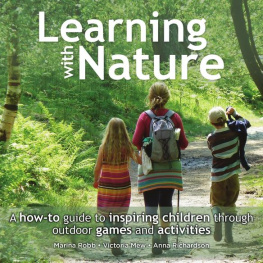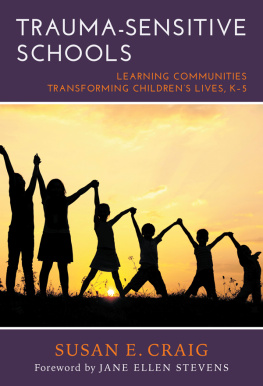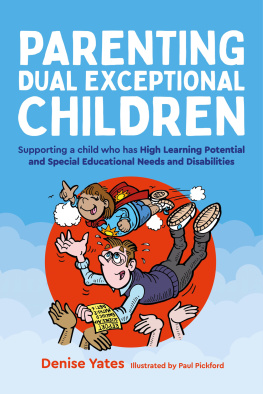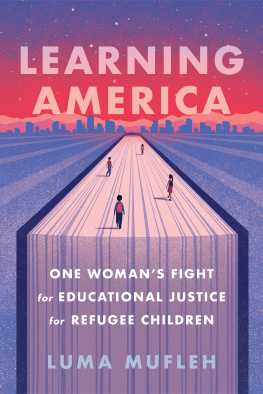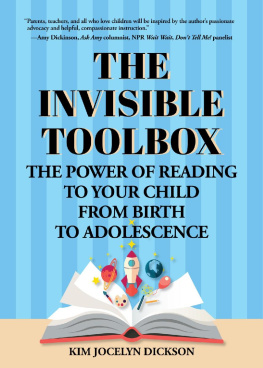Table of Contents

IMAGINE
NO CHILD LEFT INVISIBLE
Building emotionally safe spaces for inclusive & creative learning
SHELJA SEN

To all the children who face various shades of invisibility
and still hold on to their courage and dignity,
A nd to all the teachers, parents, counsellors, therapists, activists,
thought leaders and other change-makers who work every day to
make sure that there is No Child Left Invisible
You may say Im a dreamer
But Im not the only one
John Lennon
CONTENTS
Five C Approach and Model

I magine is a manifesto; it is the lifeblood of a deep conviction that I have carried with me for years. It has demanded to be written. A strong voice that kept urging me to write what I believed in. I have tried reasoning with this voice. After all, I am not a teacher and, in the strictest sense, I have never worked within the school system. However, Imagine is an idea that refused to go away. It waited patiently and grew in my mind with such ferocity that I had to sit down one day and say, Okay, lets do it!
At the outset, I would like to clarify that this book is not about academics, syllabi or curricula. In the present-day world of content overload and information at the click of a button, we need to ask ourselves some questions. Why do we send our children to schools? How can learning be meaningful? And most importantly: How can we build schools worthy of them?
At the heart of this book is a deep faith that schools need to be emotionally safe spaces for creative and inclusive learning. Schools are not just buildings that children go to learn subjects, pass examinations and get good results so that they can get admission in a good college. Schools need to be spaces where children are nurtured, allowed to think, be curious, get inspired, imagine and, most importantly, ask questions. Where they can learn to communicate, collaborate, interact meaningfully, build relationships and communities. Where they can play, laugh, love, make mistakes, fall and learn to stand up again. Where they learn about their own selves, their strengths, their vulnerabilities, their feelings. Where their bodies become stronger along with their minds and hearts and they learn the art of living, being courageous, caring for their environment, being change agents and making the right choices.
My belief is that given the right space, they will do so, each child at his or her own pace. That I believe is the essence, the bare bones of learning. Not the best school the child goes to, the top grades she gets, nor her good behaviour in class.
Three decades separate me from the first time I stepped out of my school. However, I can tell you the names of every teacher from nursery onwards and even their quirks and peculiarities. I loved my school, so it has a very happy space in my heart. Of course, I went through some difficult and painful times, but even memories of those have not displaced the happy ones from their firm grounding.
I was born and grew up in a small town in the mountains. At that time, it was a quaint little place where everybody knew everybody. I think there is no better way to describe a community. My school sprawled across several hills where we had to trek up and down through the day to go to the different classes. Each class had around twelve to twenty children, no sections. Through the years I had a mix of the most amazing and not so amazing teachers. I could go on and on telling you some fascinating stories about my school, but I will keep it for some other time. For now, there are only three things I would like to share about my school. It had a strong, inclusive culture (I am talking about a time when inclusion was not a buzzword), most of us loved coming to school, and we spent more time out in nature than in classrooms.
Maybe that is the reason why schools have such a magnetic pull for me. I love visiting schools, I love talking to people about their school life, and I love working with schools. As a child psychologist, I have worked with many schools in India and England. Seeing my own children go through their school life has given me another perspective to schooling and education.
If you ask me why I feel so strongly about it, I would ask you why not? Why doesnt everybody feel strongly about it? Each one of us has been to a school and has learned from our teachers. We send our kids off to preschools at two and half years of age and after that to schools where they stay for another fourteen years. They might leave the building at the age of eighteen, but they carry their school and their teachers in their hearts for the rest of their lives. Like each one of us has and always will. Sometimes, the schools we carry in our hearts are warm memories. However, a lot of times they are not. They are full of pain, shame, humiliation, stories of feeling unheard and being invisible.
Having made my intention clear, I would also like to clarify what I firmly believe in. Our principles highlight what we value, what gives our life meaning, keeps us going and what we aspire towards. They are more like a direction than a destination. Some days we might feel contended at how we could align ourselves with them, and some days we might feel desolate at how off the mark we have been. Like lighthouses, our principles do not change their position. We might go off course, but they stay where they are, gently shining their light, trying to show us a way in the darkness.
Each child is wired and inspired differently
I accept and love you the way you are. You are unique, you are different, and you are you. I will not compare you with others; I will not constantly keep expecting and demanding what you might not be able to do or give.
Acceptance of what is needs to be at the core of every relationship. Without acceptance, there is a constant battle of comparison, criticism, blaming, shaming and conflict. On the one hand we end up feeling like failures as we desperately try to push the square pegs into neat round holes. Children on the other hand struggle with their failures and inadequacies, which they might carry for the rest of their lives.
One size does not fit all, and that is not a limitation. It is what makes our classrooms, schools and this world such intriguing places. Maya might struggle with math, but her fingers fly as she weaves magic on the canvas with her paintbrush. Arjun might struggle academically but he comes alive on the sports field. Then there is Raghav, who does not seem to show any affinity or talent through his school years but suddenly blossoms as he finds his niche in college.
An emotionally safe space is a prerequisite to any learning
Do you remember a time and space in your school life when you think you learnt the most? What was it about that space that made it possible for it to happen?
When I ask this question, most people share a range of experiences. But, one point they all seem to agree on is how it was a space devoid of fear. Where they felt accepted and where they could raise their hands, take risks, make mistakes and ask questions without fear of being reprimanded. Where they did not feel that their answer would be met with sniggers and humiliation. Where each child felt secure of his or her position in the class and was not hounded by a sense of shame. Where he or she felt respected and did not have to fight for his or her dignity at every step.

